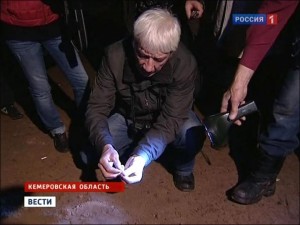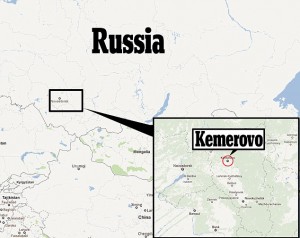New Siberian Yeti Sightings
Posted by: Loren Coleman on September 24th, 2012
A bear, a dog, a Yeti or an old woman’s hair – will there finally be a DNA test of last year’s finding in Azasskaya Cave? Photo: The Siberian TImes

Three separate ‘sightings’ of yetis have been made in Siberia in recent weeks, say fishermen and an official in Russia.
All were in the remote Kemerovo region, where around 30 ‘abominable snowmen’ live, according to the country’s leading researcher on the creatures.
In one previously undisclosed case last month near Myski village, fishermen in a boat on a river initially mistook distant figures first for bears and then people, said the Siberian Times
‘We shouted to them – do you need help?,’ said fisherman Vitaly Vershinin.
‘They just rushed away, all in fur, walking on two legs, making their way through the bushes and with two other limbs, straight up the hill.’
He said: “What did we think? It could not be bears, as the bear walks on all-fours, and they ran on two…. so then they were gone.’
On a second sighting on the bank of the Mras-Su River several days later, an unnamed fisherman was quoted saying: ‘We saw some tall animals looking like people.’
He added: ‘Our binoculars were broken and did not let us see them sharply. We waved at the animals but they did not respond, then quickly ran back into the forest, walking on two legs.
‘We realised that they were not in dark clothes but covered by dark fur. They did walk like people.’Russia sets up university institute to study the yeti after spate of sightings
Is the Yeti nesting in Siberia? Strange twisted tree arches ‘prove legendary creature exists’
In a further case this month, an unnamed forestry inspector had encountered a ‘yeti’ Shorsky National Park, according to local government official Sergei Adlyakov.
‘The creature did not look like a bear and quickly disappeared after breaking some branches of the bushes,’ he said.
This case was in Tashtagolski district, close to the border with Khakassia. No images have appeared from the alleged sightings.
Russia’s leading ‘yeti’ expert Igor Burtsev, head of the International Centre of Hominology, claimed that Myski will next month host an international conference and expedition in search of the yeti.
He said the ‘sighting’ was ‘significant’ though he was unaware of the later National Shorsky Park case.
He added: ‘We shall explore new areas, to the north from the usual places yetis have been seen previously. The conference will start in Moscow and then we will travel with our guests to Kemerovo region.’
At a similar expedition last year, he claimed to have found yeti hair though no DNA findings have been released.
He claims the creature – also known as Bigfoot and Sasquatch – is the missing link between Neanderthal man and modern human beings.
Burtsev has previously claimed a population of around 30 yetis are living in Kemerovo region.
‘We have good evidence of the yeti living in our region, and we have heard convincing details from experts elsewhere in Russia and in the US and Canada,’ he said.
‘The description of the habits of the Abominable Snowmen are similar from all over the world.’
Last November hunters claimed they had discovered the nest of a legendary Yeti in the same area of Siberia.
Experts stumbled across trees, twisted by force to form an arch, in the area which is famed for sightings of the wildman.


See also here.
About Loren Coleman
Loren Coleman is one of the world’s leading cryptozoologists, some say “the” leading living cryptozoologist. Certainly, he is acknowledged as the current living American researcher and writer who has most popularized cryptozoology in the late 20th and early 21st centuries.
Starting his fieldwork and investigations in 1960, after traveling and trekking extensively in pursuit of cryptozoological mysteries, Coleman began writing to share his experiences in 1969. An honorary member of Ivan T. Sanderson’s Society for the Investigation of the Unexplained in the 1970s, Coleman has been bestowed with similar honorary memberships of the North Idaho College Cryptozoology Club in 1983, and in subsequent years, that of the British Columbia Scientific Cryptozoology Club, CryptoSafari International, and other international organizations. He was also a Life Member and Benefactor of the International Society of Cryptozoology (now-defunct).
Loren Coleman’s daily blog, as a member of the Cryptomundo Team, served as an ongoing avenue of communication for the ever-growing body of cryptozoo news from 2005 through 2013. He returned as an infrequent contributor beginning Halloween week of 2015.
Coleman is the founder in 2003, and current director of the International Cryptozoology Museum in Portland, Maine.











Well Siberia is remote enough with a great deal of forest. If these animals do exist Siberia is a good place for them.
If this region is actually a hotspot for these creatures, why not send in a low-impact investigation that consists of ONE field researcher equipped with a head-mounted camera that streams video and audio back to a central location where the feed is constantly recorded and monitored. Everything the researcher sees and hears is preserved. I’m betting that one guy roughing it alone in the wild would have better luck at an encounter than a team of idiots bellowing at the top of their lungs and whacking trees with sticks. One can certainly dream! 🙂
Great post, looking forward to hearing what results they get from the expedition
The Russians really love their Yetis, Almastys, whatever. And hey… SO DO I!!
I think there is a chance that the Yeti lives in Siberia because of its terrain.
Squatchman: there is more than one creature named “Yeti” (as per Ivan Sanderson’s ABOMINABLE SNOWMEN); it’s a popular catch-all that encompasses the Meh-Teh, Yeh-Teh, and Dzu-Teh (sometimes a fourth, Kang Admi (sometimes Kangmi). Westerners, not recognizing more than one creature, use the term “Yeti”. Other names exist, in less common form.
And since Bigfoot exists in varied terrain, from alpine to (seemingly) swamplands, we may expect Asian counterparts would do the same. And you undoubtedly know that swamps exist in great profusion in Siberia. Boy, do they ever.
Some parts of Sanderson’s book seem outdated now, 40-plus years later, but on the whole, it holds up very, very well!